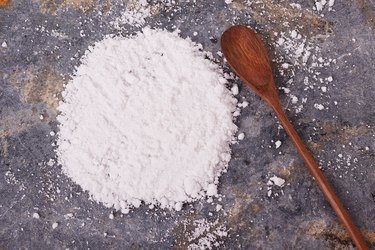
Cassava isn't something Western cultures eat much of, but it's a staple food in the tropical regions where it's grown. If you're a gluten-free baker, you may be considering trying cassava flour in place of regular flour. You don't need to avoid cassava flour, but it's not the most nutritious option.
Tip
Cassava flour is made from the starchy root vegetable. It's high in carbs, but it doesn't contain some of the healthful nutrients other flours provide, so you should eat it in moderation.
Video of the Day
What Is Cassava Flour?
Cassava is a starchy root vegetable and a major source of carbohydrates in many parts of Africa, Southeast Asia and South America. According to the USDA, people in Africa also eat the leaves of the cassava plant, and the juice can be fermented to make a syrup and a liquor called kasiri. To make flour, the cassava root is roasted or sun-dried and ground.
Video of the Day
In Africa, cassava flour is used as a partial substitute for wheat flour, and that is how it is primarily used in the West — as grain-free replacement for wheat and other grain-based flours. This is a boon for those who can't eat gluten, as well as those who follow restrictive diets such as the Paleo diet and the Whole30.
Nutrition of Cassava Flour
But how does it stack up nutritionally? It's an important source of nutrition for many people all over the world, but is it the best choice for someone who has access to a wide array of other flours?
That depends on what you're comparing it to. If you're measuring it up against all-purpose white flour, it's nutritionally superior. White wheat flour has been refined and stripped of fiber, protein, vitamins and minerals. Cassava flour provides more protein and fiber than white flour, according to data from the USDA National Nutrient Database.
Whether it beats out the vitamin and mineral contents of white flour depends on whether or not it has been enriched or had synthetic nutrients added to it.
In comparison to whole-wheat flour and common gluten-free flours, including almond, brown rice and chickpea flours, cassava doesn't fare as well. Cassava doesn't provide any protein, but whole wheat, brown rice and chickpea flours are rich sources with between 7 to 22 grams per 100 grams of flour.
Cassava flour has more fiber than rice flour but less than whole wheat and chickpea flours. Cassava flour is lower in vitamins and minerals than enriched white flour, whole-wheat flour, chickpea flour and brown rice flour.
Cassava Poison Risk
You may have heard warnings that you should avoid cassava because it's poisonous. However, this is both true and false. The plant does indeed contain cyanogenic glycosides, which are chemical compounds that are present in more than 2,000 plant species, according to the Centre for Food Safety of the Government of Hong Kong Special Administrative Region.
On their own, these compounds are not very harmful, but when they are broken down during digestion, they release hydrogen cyanide, which is toxic to humans and other animals.
How much of these compounds cassava has depends on the type. Sweet cassava is relatively low in them, with less than 50 milligrams per kilogram, whereas bitter cassava contains significantly higher amounts — more than 400 milligrams per kilogram. The USDA warns that bitter cassava should not be eaten raw, but it is OK to eat it cooked.
Should You Eat It?
Most commercial cassava flour has been properly processed to remove the harmful glycosides and carries no risk of cassava poisoning.
According to the Centers for Disease Control and Prevention, that involves soaking the roots in water for several days, then drying them in the sun or roasting them. After that, the outer covering is removed and the roots are ground into flour. If any of these steps are not thoroughly executed, the levels of cyanogenic compounds remain high.
Although rare, there have been cases of cyanide poisoning from improperly processed cassava flour. Manufacturers can test their products before they reach the consumer to ensure safety. When choosing a product, check to see that this testing has been performed.
From a nutritional standpoint, cassava flour isn't your best choice. It's high in carbohydrates but low in fiber and protein compared to alternatives. Whenever possible, choose alternative flours with higher nutritional value, such as brown rice, chickpea, almond and coconut flours.
- USDA NRCS National Plant Data Center: "Cassava"
- Harvard T.H. Chan School of Public Health: "Whole Grains"
- USDA: "Moon Rabbit Foods, Premium Cassava Flour"
- USDA: "Wheat Flour, White, All-Purpose, Enriched, Bleached"
- USDA: "Wheat Flour, Whole-Grain (Includes Foods for USDA's Food Distribution Program)"
- USDA: "Chickpea Flour (Besan)"
- USDA: "Rice Flour, Brown"
- Centre for Food Safety of the Government of Hong Kong Special Administrative Region: "Cyanide Poisoning and Cassava"
- Centers for Disease Control and Prevention: "Outbreak of Cyanide Poisoning Caused by Consumption of Cassava Flour — Kasese District, Uganda, September 2017"